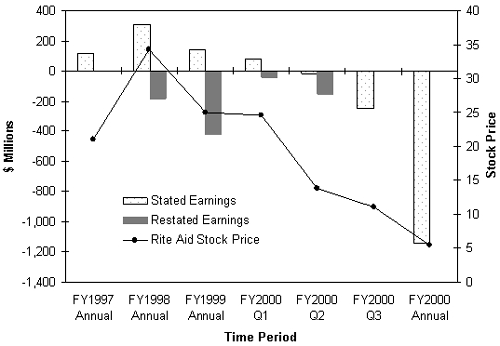Fraud, Plain and Simple
| The pressure on accounting departments to smooth earnings or even produce earnings can be intense when the firm is not meeting investor (analyst) expectations. Since the role of accounting has changed and accounting departments are viewed as profit centers, they are pressed to make up shortfalls created by the business operations of the firm. Sometimes, firms cross way over the line to fraudulent practices. Consider the case of Rite Aid Corp. On June 21, 2002, a federal grand jury indicted four former and current executives of the firm for conducting a wide- ranging scheme to overstate income. [7] The SEC noted in its investigation that Rite Aid reported false and misleading information in ten different areas ”ranging from reducing its costs to accelerating revenue to manipulating numbers between quarterly and annual reports . [8] Indeed, Rite Aid restated earnings for its fiscal year 1998 that caused $305 million in net income to become $186 million in net losses. The restatement in fiscal year 1999 changed from a $143 million profit to a $422.5 million loss. That is more than $1 billion in earnings that disappeared! Figure 5-2 shows the price of Rite Aid's stock from 1997 to 2000 and its relationship to the stated and restated earnings. Rite Aid stated that it earned $116.7 million in fiscal year 1997 (which ended February 28, 1997). The stock price at this time was $21 per share. As indicated earlier, Rite Aid then stated that it earned $305 million in 1998, and the stock price rose to $34.25. The stock price reached its maximum of $50.94 on January 8, 1999. A few months later the firm reported fiscal year 1999 earnings of $143 million. However, investors started to figure out that something was wrong. By July 10, 2000, the stock had slowly fallen to $7.85 per share. The stock price fell to $5 per share the next day when Rite Aid restated its earnings from 1998 to 2000. The stock spent the summer of 2002 at under $2.50 per share. Figure 5-2. The statement and restatement of Rite Aid's earnings and associated stock price. Rite Aid's stock price was artificially inflated in the late 1990s because of fraud in financial reporting. Those investors who purchased Rite Aid's stock in 1999 because they thought the firm was a profitable and growing company were lied to and lost a lot of money. Even the existing investors would have been better off knowing the extent of the firm's loss so that they could have made an informed decision to stick with it or sell out. After the truth finally came out, it was too late ”they had lost most of their investment in the company. Whereas Rite Aid's fraud was hidden in at least ten different types of accounting manipulations, WorldCom Inc.'s gaffe was one of the oldest and simplest tricks in the book. On June 25, 2002, WorldCom disclosed that roughly $3.8 billion had been improperly booked as capital investments instead of operating expenses over the previous five quarters . This is especially distressing because WorldCom is such a large and well-known company. Twenty million Americans were MCI customers, and superstar Michael Jordan was the company's pitchman. [9] Specifically, WorldCom had to pay fees to other phone companies in order for them to transfer WorldCom customers' calls right away. [10] By capitalizing these fees, contrary to GAAP, WorldCom pushed current expenses into the future, thereby boosting current earnings (at the expense of future earnings). For example, by inappropriately capitalizing the $3.8 billion and depreciating it over, say, five years , the firm did not report the $3.8 billion as an expense, which would have lowered its pre-tax earnings by $3.8 billion. [11] Instead, it only had to claim one fifth of the cost as depreciation, which would have lowered its pre-tax earnings by only $0.76 billion. In this case, WorldCom would have fraudulently increased its pre-tax earnings by $3 billion. As a comparison, WorldCom's income before taxes was only $3.6 billion in the previous five quarters. In other words, nearly all of it was fictional. While this was simply a case of cooking the books, the scheme seems to be especially effective considering that as a telecom firm, WorldCom needed to make many capital investments in phone lines, satellites , and equipment. Therefore, hiding expenses as capital investments was easy. WorldCom's deception is even more problematic when considering that many analysts and investors follow an accounting measure other than earnings for firms with high capital investment needs. They follow the measure EBITDA (earnings before interest, taxes, depreciation, and amortization). One of the things this measure excludes is depreciation expense. In the example above, EBITDA would not have the $0.76 billion in depreciation expenses deducted and therefore would be higher by the full $3.8 billion (in the scheme). Thus, this scheme is especially misleading for investors who follow EBITDA instead of earnings. |
EAN: 2147483647
Pages: 118
